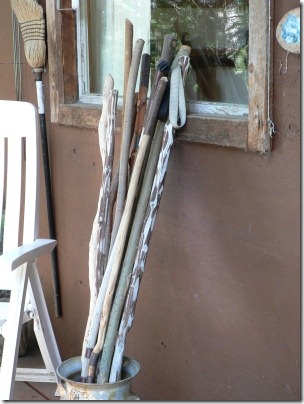 I am drawn to the earth. Imbued by biota. My collection of walking sticks tells me I’m as much flora as fauna. Cutting spirals in bark and peeling it back with my fingers, running my palm over the slick wetness of the white wood, the whorls of bark, corkscrew shavings and woody cuticles at my feet, and the live length of wood in my two hands, measured against the horizon, puts me in the earth’s kitchen.
I am drawn to the earth. Imbued by biota. My collection of walking sticks tells me I’m as much flora as fauna. Cutting spirals in bark and peeling it back with my fingers, running my palm over the slick wetness of the white wood, the whorls of bark, corkscrew shavings and woody cuticles at my feet, and the live length of wood in my two hands, measured against the horizon, puts me in the earth’s kitchen.
I am not an artisan. My walking sticks are not art. I have been given walking sticks that are works of art that I cherish, but I can’t go hiking with them. The hand staffs I make are pedestrian, peripatetic pieces for cranking up hills and balancing over streams and turning aside underbrush. They are tools for digging up shells and flipping over stones and staking a flysheet and poking at the unknown.
Walking along the trails in the ecotone of the parkland and boreal forest, especially after a summer storm or a blizzard, any broken or bent limb, large shrub, or sapling, becomes a potential prize. Aspen, balsam poplar, white birch, tamarack larch, jack pine, all possibilities.
And in mixed spruce and aspen woodlands I search the understory for large shrubs. Most are undersized for walking sticks but occasionally I’m presented with a red-osier dogwood or beaked hazelnut that works. Saskatoon, pincherry, chokecherry I think would make fine walking sticks, if they grew larger.
But I like willow. I scan the trail sides and draws for willow; beaked, grey, or pussy willow. There are four hundred willow species. I have never been lucky enough to find a diamond willow. And it wasn’t until recently that I learned that diamond willow is not a species but a fungus that causes diamonding.
A proper find is critical, and sometimes the finest part. I have an 18 year old willow walking stick that I found along the North Saskatchewan. It was perfectly prepared by a beaver and left for me–needing only its narrow end cropped.
When a bent or broken limb finds me, I take it into my hands, draw my red-handled pocket knife and carefully etch a notch around the base, this is the thicker part where I’ll want the handle to be. The notch allows an easy break. The correct measurement is important but I always allow for extra length rather than making an early, short judgment.
The process of walking stick making, the finding, trimming, debarking and marking is somehow sacred. Does this surprise you? There is energy and life in the wood. It gives itself up, retaining its substance but changing to serve. As I roll it over in my hands taking note of knots and furls it finds its purpose, as do I.

This brings back memories of many wonderful walks together and my own beautiful walking stick.
The idea of the sacred walking stick led me to think about the cross – not as a burden to be born, as I’ve usually thought, but as a walking stick….
Thanks Deb…I recall that walking stick.
Sam, I like your leaps. And this one in particular.
My brother finds and decorates walking sticks. He has made one for each of us nine siblings as a gift when we reach the half-century mark. I will send him the link to this article.